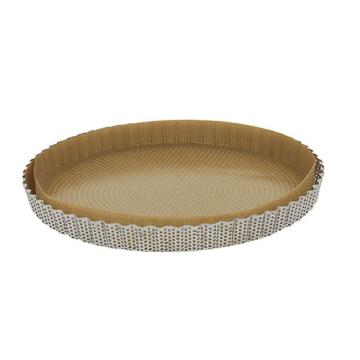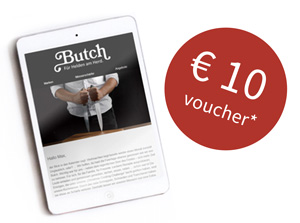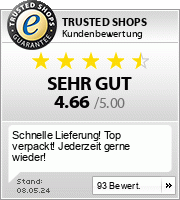
Preparing and Serving Tartes & Quiches
In this section, you will find baking molds and useful kitchen tools related to the topic of “Tartes & Quiches”: tart pans, tartlet molds, quiche pans, baking molds with fixed or removable bottoms, pizza cutters, spatulas, palettes, and much more.
Tartes and Quiches can be served as an appetizer, main course, or dessert, depending on the topping. Since the shortcrust pastry, which serves as the base for both dishes, is often not seasoned, containing neither salt nor sugar, the flavor is determined solely by the topping. Nowadays, shortcrust pastry is sometimes replaced by puff pastry, as people are not as strict with the original recipes anymore.
Butch offers tart and quiche molds made of ceramic, stainless steel, and non-stick coated steel. These materials are well-suited for an even baking result. The dough is rolled out flat, pressed into the round mold, and pulled up at the edges. We recommend pre-baking the shortcrust pastry before adding the topping, depending on the topping or filling.
A basic recipe for a shortcrust pastry base and more interesting information about Tartes and Quiches can be found below the product overview for you.
Tartes & Quiches
When you take a closer look at the topic of „Tartes & Quiches“, you quickly realize that there is a lot of sometimes contradictory information about both dishes. We at Butch try to shed some light on the darkness of the oven:
Tarte
In French cuisine, a „Tarte“ is a flat cake with a base made of unsweetened shortcrust pastry. The topping for the tarte can be either sweet or savory. The tarte is baked in special molds that have a low height and often feature the typical fluted edge. Mini-tartes baked in small molds are called tartelettes. Topped with fresh fruits, they are wonderfully suited as a small appetizer or sweet finger food.
Quite well-known, even here, is the Tarte Tatin, a traditional French apple pie that is baked „upside down“. Characteristic of the apple pie, also known as „Tarte du Chef“, is the caramel layer that forms on the bottom of the baking dish and later covers the apples when the pie is inverted.
Quiche
The „Quiche“ also originates from France and originally comes from the Lorraine region. Here, too, it is a round, flat shortcrust pastry, but with a savory topping that is covered with a cream-egg mixture. A classic is the Quiche à la lorraine or simply „Quiche lorraine“, a Lorraine bacon pie that is now internationally known and loved. Due to its richness, this quiche is often found as a main course on the menu.
In the past, the dishes or recipes behind the two terms were actually precisely defined. Nowadays, a broader use of the two terms has become established. A still characteristic difference that is often found is the height of the baked goods. Usually, the tarte is flatter than the quiche, but even that is no longer a reliable distinguishing feature.












